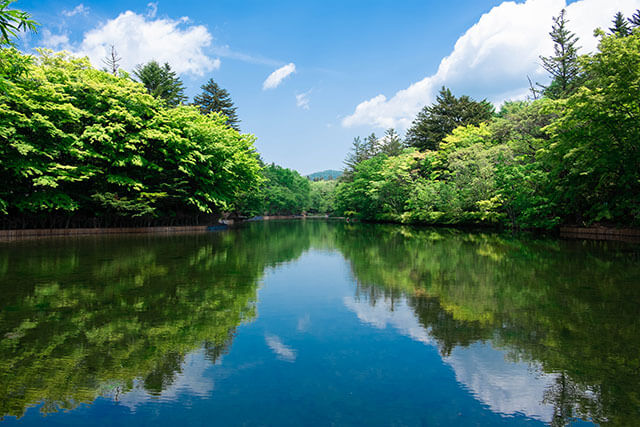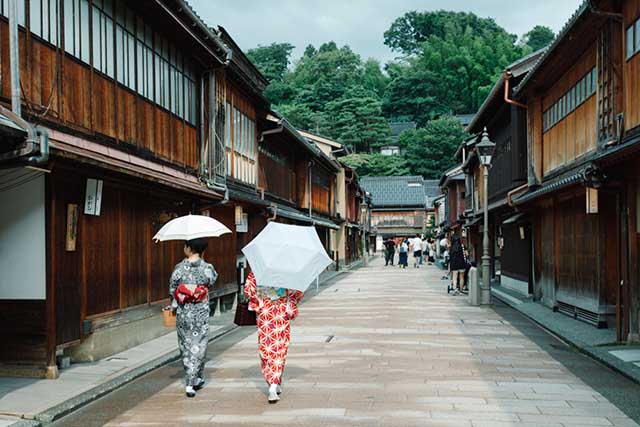
Did you know that you can take advantage of unlimited rides over seven days from major airports/stations in Osaka and Tokyo to the Hokuriku area? In this article, we will introduce the Hokuriku Arch Pass, which allows you to travel freely on the Hokuriku Shinkansen and Limited Express trains while experiencing everything the Osaka, Tokyo, and Hokuriku areas have to offer. We’ll explain why it’s an affordable option for traveling around the region and offer a recommended itinerary to help you make the most of your week.
-
01
What is the Hokuriku Arch Pass?
Designed for tourists visiting Japan, the Hokuriku Arch Pass is a rail pass that allows you to use the Hokuriku Shinkansen and Limited Express trains from major airports and stations in Osaka and Tokyo to the Hokuriku area. It’s valid for use on the Limited Express Thunderbird from Osaka to Kanazawa, the Haruka from Kansai Airport to Shin-Osaka, the Narita Express (N'EX) from Narita Airport to Tokyo, and the Hokuriku Shinkansen (Kagayaki, Hakutaka, Asama, and Tsurugi) from Tokyo to Kanazawa.
![Hokuriku Arch Pass]()
Hokuriku Arch Pass
In addition, you can ride trains traveling between Tokyo’s Narita and Haneda Airports to Fukui, Kanazawa, and Toyama or connect to Kyoto, Kobe, Nara and Kansai Airport in Osaka region.
The pass is valid for seven consecutive days and also includes discounts (or complimentary gifts) at tourist facilities on buses and railways in the Hokuriku area. You can find out more about the Hokuriku Arch Pass and what it offers at https://hokuriku-arch-pass.com/en/. -
02
Where to buy the Hokuriku Arch Pass
The Hokuriku Arch Pass can be purchased at the Midori no Madoguchi at Narita Airport Station, as well as JR East Travel Service Centers at Narita Airport Terminals 1, 2 and 3, Tokyo Monorail Line Haneda Airport International Terminal Station, Tokyo Station, Shinjuku Station (East Exit and New South Gate), the View Plaza at Nagano Station, and Yokohama Station. They are also available at the JR East Travel Centers at Shibuya Station, Ikebukuro Station, Ueno Station, Hamamatsucho Station, and Shinagawa Station.
In the West Japan area, you can purchase the Hokuriku Arch Pass at Kansai Airport Station, Osaka Station, Shin-Osaka Station, Kyoto Station, Kanazawa Station or Toyama Station.
If you want to purchase a pass before arriving in Japan, you can obtain an exchange order online or from designated travel agencies overseas, then exchange it for the Hokuriku Area Pass at the locations listed above. The exchange order is valid for three months from the date of issue.
It’s important to remember that only foreign nationals with a passport other than those issued by Japan and who are visiting for a short-term stay (90 days or less) can purchase the Hokuriku Area Pass. Your passport will be checked at the time of purchase or exchange to ensure you are eligible. -
03
Prices
If you purchase a Hokuriku Area Pass overseas, they cost 24,440 yen for adults (12 years and above) and 12,220 yen for children (6 to 11 years old). If purchased in Japan, prices are slightly higher - 25,460 yen for adults and 12,730 yen for children. Children younger than 6 years of age are classified as infants/toddlers and can travel free with a paying adult or child.
N.B. There was a price change for the Hokuriku Arch Pass on October 1, 2019.
To give you an idea of the savings the Hokuriku Area Pass offers, if you were to travel from Osaka to Kanazawa, it would regularly cost you 7,260 yen for a one-way ticket, with the journey taking two hours and 46 minutes. If you were traveling from Tokyo to Kanazawa, it would cost you 14,380 yen, with the journey taking two hours and 30 minutes.
These two trips alone add up to 21,640 yen, so you would only have to take one additional train trip to make the Hokuriku Arch Pass worthwhile. As such, it’s a convenient option for travelers wanting to explore the Hokuriku region, which includes the prefectures of Ishikawa, Fukui, and Toyama. -
04
Recommended itinerary for the Hokuriku Area Pass
To help you make the most of your Hokuriku Arch Pass, here’s a recommended seven-day itinerary for exploring the region.
-
05
Day 1: Start from Tokyo!
![Tokyo Asakusa]()
Tokyo Asakusa
Begin in the Japanese capital, Tokyo, to photograph the famous Scramble Crossing in Shibuya and witness the Kaminari-mon Gate that leads to the historical temple of Senso-ji in Asakusa. Soak up the views across the city from the Tokyo Skytree and stroll through the Shinjuku Gyoen National Garden, then get your cultural fix in the museums and art galleries of Ueno Park.
Tokyo is also renowned for its diverse neighborhoods and shopping districts, including Harajuku, Ginza, and Akihabara. You can explore the East Gardens and the Edo castle ruins of the Imperial Palace or get up close to marine species from across the globe at the Sumida Aquarium. When it’s time to eat, Tokyo boasts some of the best restaurants and dining experiences in the country, not to mention a pulsing nightlife and diversity of bars and clubs that stay open into the early hours of the morning.
Read More:Tokyo’s Top 20 Destinations You Should VisitThe Tokyo Station Hotel
1-9-1 Marunouchi, Chiyoda-ku Tokyo

-
-
06
Day 2: Karuizawa
![Karuizawa]()
Karuizawa
From Tokyo, travel northwest onboard the Hokuriku Shinkansen to the popular mountain resort of Karuizawa, which nestles at the foot of volcanic Mount Asama. It lies at an altitude of around 1,000 meters, making it an idyllic place to escape the heat during the summer months and has been popular with Western residents of Japan since the late 19th century.
You can follow the short forest trail that leads to the photogenic Shiraito Waterfall or take in the views from the Usui Pass Observation Deck, then admire the reflective waters of the Kumoba Pond. Browse the shops that line the old town streets of Kyu-Karuizawa before spending the night at the popular Hoshino Resort, a luxurious ryokan with both indoor and open-air baths set within stunning natural surrounds. If you’re visiting in the summer months, Karuizawa is an ideal location for cycling, hiking and golfing while in wintertime there is skiing and snowboarding on offer.
Read More:31 of the Best Things to Do in Karuizawa -
07
Day 3: Toyama
![Toyama]()
Toyama
Continue traveling northwest onboard the Hokuriku Shinkansen to the coastal city of Toyama, a former castle town that overlooks the Sea of Japan. It’s become increasingly popular with tourists in recent years thanks to its restored 16th-century castle and museums dedicated to history and art, including the renowned Toyama Glass Art Museum. You can step inside a traditional Japanese home at the Rakusui-tei Museum of Art and take in the scenic views of the Tateyama Mountains from Kansui Park before feasting on delicious sushi made using fresh seafood.
Toyama is also a good base for riding the Kurobe Gorge Railway Trolley Train (also known as the Torokko Train), which offers magnificent views across one of Japan’s deepest gorges. It was originally built to assist in the construction of the country’s largest arch dam, the Kurobe Dam, with the 80-minute journey taking you across more than 20 bridges and past several hot springs where you can stop to bathe.
Read More:Escape to Toyama for a laid-back slice of Japanese life, at the foot of the Northern AlpsHotel Vischio Toyama
1-231, Meirintyou, Toyama

-
-
08
Day 4: Kanazawa
![Kanazawa]()
Kanazawa
Ride the final leg of the Hokuriku Shinkansen to Kanazawa, which serves as the capital of Ishikawa Prefecture and has a rich history as the seat of the Maeda Clan. It managed to survive World War II relatively unscathed, with several atmospheric Edo-era districts to explore where the traditional culture remains strong.
Stroll through the Higashi Chaya District, which is lined with old teahouses where geisha perform, and visit the Nagamachi Samurai District to explore its narrow laneways and earthen walls. Kanazawa is famed for its reconstructed 16th-century castle and Kenrokuen, which is considered one of Japan’s three most beautiful gardens.
While visiting Kanazawa, don’t miss the opportunity to eat at the famous Omicho Market where you can sample the freshest seafood in the city. Other highlights include the 21st Century Museum where contemporary art is exhibited and the D.T. Suzuki Museum that commemorates the life and work of this famous Japanese philosopher.
Read More:30 of the Best Things to Do in KanazawaKanazawa City, Customized Private One Day Tour
¥27,718
Update date:2024/04/27
Via Inn Kanazawa
1-1 Kinoshinbo-machi, Kanazawa

-
-
09
Day 5: Kyoto
![Kyoto]()
Kyoto
From Kanazawa, travel southwest onboard the Thunderbird Limited Express to the former capital of Japan, Kyoto, which is famed for its Buddhist temples, Shinto shrines and traditional wooden houses. Visit the UNESCO World Heritage-listed Kiyomizu-dera Temple and the 17th-century Nijō Castle, as well as the Zen temple of Kinkaku-ji that’s covered in gold leaf.
You can rent a kimono to stroll through the preserved historic district of Higashiyama and witness the beautiful stone garden of the Nanzen-ji temple. Capture a selfie in the photogenic bamboo groves of Arashiyama and marvel at the moss garden of Gioji Temple before hiking through the thousands of vermillion torii gates that lead to the Fushimi Inari Shrine.
When it comes to cuisine, Kyoto is particularly famed for its kaiseki dining, which consists of multiple courses, as well as the geisha teahouses and restaurants that cluster in the Gion district.
Read More:Visiting Japan: Top 43 Things to Do in KyotoSanco Inn kyoto-Hachijoguchi miyabi Shikinoyu
48-1, Higashikujo Kamitonodacho, Minami Ku Kyoto

-
-
10
Day 6: Nara
![Nara]()
Nara
From Kyoto, travel south to the city of Nara, which was established as Japan’s first permanent capital in 710 AD. It’s renowned for the wild deer that roam in Nara Park (you can even eat deer crackers that are sold nearby) and home to the Tōdai-ji temple and its 15-meter-tall bronze Buddha known as Daibutsu. On the park’s eastern side you’ll find the 3,000+ lanterns of Kasuga Taisha, Nara’s most celebrated Shinto shrine and dedicated to the deity who’s responsible for protecting the city.
Also not to miss in Nara is the Kofuku-ji Temple (the former family temple of the Fujiwara) whose five-storied pagoda has become a symbol of Nara. A highlight on Nara’s calendar is the annual Omizutori festival, which is held at Tōdai-ji temple each March and sees burning embers held from the balcony of Nigatsu-dō and showered over the crowd to bestow them with a safe year.
Read More:World Heritage locations in NaraSuper Hotel Lohas JR Nara Station Natural Hot Spring
1-2 Sanjo-Honmachi Nara

-
-
11
Day 7: Finish in Osaka!
![Osaka]()
Osaka
Finish your journey in the lively city of Osaka, which has a unique culture that can be seen in its local dialect and distinctive cuisine, including a vibrant street food scene. Soak up the views across Osaka from the landmark Tsutenkaku Tower and explore the streets of Shinsekai, a neighborhood inspired partly by New York and partly by Paris.
While in Osaka, don’t miss the opportunity to have your photo taken at the 16th-century Osaka Castle, built by Hideyoshi Toyotomi to promote the unification of Japan during the Sengoku or Warring States period (mid-15th century to early 17th century). Osaka is also home to one of Japan’s oldest Shinto shrines, Sumiyoshi Taisha, which was founded in the 3rd century AD (before the introduction of Buddhism).
Once the sun goes down, head to the canal-front Dotonbori area to feast on authentic Osaka okonomiyaki and skewers while experiencing its pulsing energy and neon billboards.
Read More:The Ultimate Osaka Guide 2020; What to Do and What to Eat



 Go here
Go here






































